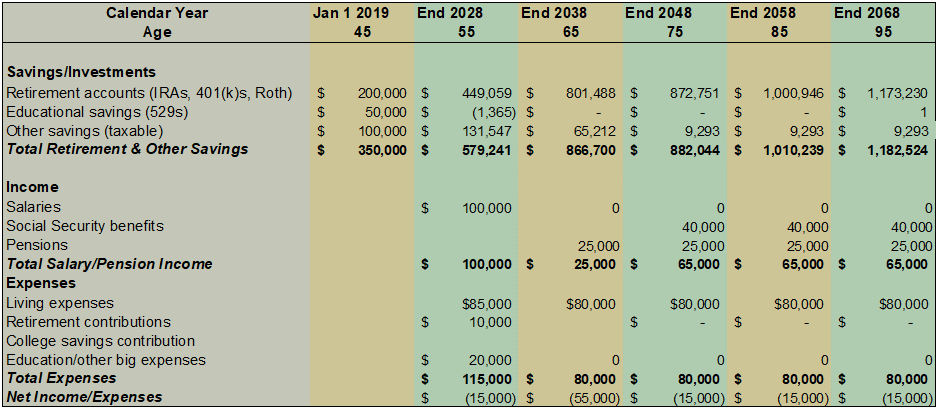Create Your Retirement Plan: the Eightfold Path

source: larchedegloire.com
Do you have a financial plan for your retirement? Do you need one? What exactly is a retirement plan, anyway? If your answers to these questions are a bit vague and uncertain, read on! This post will lay out why you need a plan for the years after you stop working (yes, you should have a plan), and how to go about creating one. The good news is it’s not that hard to do. In fact, if you’ve been reading my posts until now (and, of course, following up on my recommendations!), you’re 80% of the way there already. This post pulls the pieces together into a single whole; eight steps leading to enlightenment — at least about your financial future.
Why Do You Need a Plan?
Perhaps you’re in your working years, and have dutifully been putting away 10% of your income – maybe even 15% — every year in a 401(k). Well, most years anyway – when you didn’t need the money for a house down payment, or a new car. Also, you struggle some with whether to put money into retirement savings or a college fund for your kids; it seems a stretch to do both. You worry about whether your parents, who are getting older, are going to need some help down the line. Meanwhile, you and your spouse, who are both healthy and adventurous, have talked about retiring early – maybe at 55 – buying a sailboat and traveling the world. You’ve also talked – maybe dreamed would be more accurate – about getting a little cabin on the coast.

Does this constitute a retirement plan? The answer is probably pretty obvious. Dreams and aspirations by themselves do not make for a plan. In fact, you (in this example) don’t really know whether you’re on track to retire at 65, let alone 55. Nor is it clear whether you’ll be able to send your kids to the college of their choice, let alone buy a sailboat or a cabin. Your retirement, when you think about it realistically, may be more a source of worry than excitement.
This is why you need a plan. You need to know whether those future dreams are realistic, and whether you are on track to achieve them. The only way to do this is to sharpen your pencil and crunch some numbers. This doesn’t need to be a particularly onerous task; there are many software tools that can make it fairly painless. If you’re so inclined, you can do what you need to do on your own computer or even with paper and pencil. Once you map things out, you may find you need to make some adjustments – save more, retire later, get a smaller sailboat – to make the numbers work. But the rewards are great; knowing whether or not you’re on track to realize your dreams is a good feeling – much better than worrying, wondering and hoping. If you’re about to retire, or even already in retirement, it’s still important — and not too late — to have a solid plan. Ready? Let’s get started.
Step 1: Begin by Setting Goals

Source: Jetsetter
Hold off for a moment on firing up the spreadsheet. The first, very important, step in planning is to define your goals. If you’re a couple, you should sit down and do this together to make sure you’re on the same page. Couples often have different ideas on when to retire and what they’d like to spend their time doing. Discussion and compromise may be required!
Defining your goals should not just be a financial exercise. What do you actually envision doing when you stop work? Do you want to stay where you are or move to some idyllic (or cheaper) location? Do you have interests or hobbies that will keep you busy or do you think you might want to work part-time to avoid going stir-crazy?
A comfortable retirement is going to be the biggest goal for most people, but you should also identify other goals, especially if they’re likely to have a significant impact on your finances. They may include aspirations like those listed above – retiring early, traveling the world, getting that dream cabin, sending your kids to college. You may also have responsibilities, such as caring for an aging or disabled family member, which you should include in your plans.
You will very likely need to prioritize: supporting your kids through college and not being a burden in your old age might be more important than retiring early. Write your goals down so that you can see them all in one place and prioritize them more easily. OK? Now let’s translate your life goals into specific assumptions and numbers – a plan.
Step 2: Estimate Your Spending in Retirement (see this post)
You’ll need to estimate how much money you’re going to spend each year in retirement. Retirement planners sometimes recommend assuming that your retirement spending will be 70 to 85% of your pre-retirement income. This sort of rule-of-thumb estimate is OK if you’re many years from retirement, but if you’re getting close you should take the time to come up with something more accurate.
I recommend estimating retirement spending (and your other multi-year projections below) in today’s dollars – that is, netting out inflation. This makes it easier to project expenses over time (you can simply project your current spending level without adding some sort of guess on inflation), and makes it easier to interpret all your out-year estimates (you don’t have to adjust for changes in purchasing power – a dollar in 2050 buys the same amount as a dollar today).
If you’re already retired, estimating spending is easy – it’s your current spending level (plus or minus any expenditures you’re pretty confident will change).
If you’re not yet retired, you’ll need to come up with an estimate based on your current expenses. Look at your current annual budget – what you’re actually spending money on, not some aspirational ideal. (This is most easily done if you use an online budget tracking program — often offered for free by banks and brokerages.) Then adjust for items you know or expect will be different once you’re retired, including:
- Social Security, Medicare and pension contributions, which will cease.
- Travel, recreation and hobby spending, which may go up.
- Health care/medical costs, which will likely go up. (Health insurance costs can be a brutal surprise to retirees. Even after Medicare kicks in at age 65, there are insurance premiums and other costs.)
- Kid-related expenses, which may go down once kids are out of the house.
Your spending estimate doesn’t have to be perfect, but should be roughly right. Be careful about assuming a much lower cost of living based on the assumption that you’ll be living somewhere else, unless you’ve tested or otherwise confirmed your assumptions.
Example: Estimated Retirement Expenses for a Couple
| Expense Category | Annual Amount |
| Pre-retirement household expenditures (including taxes) | $100,000 |
| Reduced Social Security/Medicare/Retirement contributions | ($25,000) |
| Additonal travel, hobby, recreational costs | $7,000 |
| Additional health care costs (after 65/Medicare) | $8,000 |
| Estimated retirement spending | $90,000 |
Step 3: Estimate Your Income in Retirement
Next, estimate your income in retirement. This will include expected social security benefits (you can get an estimate from mysocialsecurity.gov), pensions you have coming to you (contact the agency providing the pension to get an estimate), and any annuities or other sources of regular income you anticipate. Make sure you consider your options: it’s generally a good idea for the higher earner to defer Social Security to 70, and to choose the pension benefit that provides maximum benefit to the survivor (see this post and this one). Both of these choices protect the surviving spouse from a precipitous income drop when the first spouse dies. Pay attention to the year(s) your income sources come online.
Example: Couple’s Estimated Retirement Income
| Income Source | Age | Amount |
| Spouse A – Pension, govt job | 65 | $18,000 |
| Spouse A – Social Security – Full Retirement Age – Deferred | 67 70 | $22,000 $28,000 |
| Spouse B – Pension, teaching job | 65 | $12,000 |
| Spouse B – Social Security (Full Retirement Age) | 67 | $12,000 |
| Total Anticipated Income | 70 | $70,000 |
Step 4: Project Your Assets
Most peoples’ anticipated expenses in retirement will exceed their expected income (often just Social Security retirement benefits). Withdrawals from a portfolio of assets will need to make up the difference. A key aspect of retirement planning is estimating how much in the way of assets you will need to cover the gap and how to manage your portfolio (and withdrawals, once in retirement) to make your portfolio last.
If you’re at the point of retirement (or already in retirement), you know what your retirement assets are; they are your current savings and investments, less any big anticipated expenses (such as college costs or weddings), plus any expected financial windfalls you expect to come your way (e.g., inheritance, downsizing gains). If you’re a few years from retirement, add the amount you expect to contribute to your savings by the time you retire. If you’re more than a few years from retirement, you’ll want to account for some growth in the value of your invested assets (see Step 5, below).
In your first run-through, look only at your liquid assets (stocks, bonds, CDs, IRAs, etc.) – not your house, because it’s not easy to draw down your house as income. If you simply don’t have enough, you can include the value of your home and consider ways you could tap that equity (e.g., downsizing). A reverse mortgage should be a last resort.
Example: Couple’s Estimated Retirement Assets
| Asset Type | Amount |
| Traditional IRAs and 401(k)s (total, both spouses) | $300,000 |
| Roth IRAs (total, both spouses) | $160,000 |
| Non-retirement savings | $100,000 |
| Planned retirement contributions (two years till retirement) | $40,000 |
| Home (equity value) | $400,000 |
| Total liquid assets (w/o home) | $600,000 |
| Total assets including home | $1,000,000 |
Step 5: Put It Together – Do You Have Enough? (see this post and this one)
This step is the crux of your retirement plan – putting your expenditure, income and asset information together into a financial projection for your retirement. Unless you have a good reason to think otherwise, you should assume that you (or at least one of you, if you’re a couple) will live a good long time – until 95 or even 100. Life expectancies are lengthening, and you don’t want to outlive your money. For most couples, this will mean a retirement horizon of 30 years or so.
If you have reliable sources of income (social security, pensions from sources you can count on), that cover most of your expenses, you are in good shape – and also the exception. Most people are in the position of relying on their retirement investments for a significant portion of their income. In this case, it’s hard to know for sure whether your money will last, because of the variability of investment returns and, in particular, sequence of returns risk – the possibility that you will experience terrible stock market returns in the first decade or so of your retirement. The only way to avoid this risk is to invest so conservatively that there is little prospect of gain – not an option for most people. Fortunately, there are reasonable strategies for threading this needle – taking on some risk (so your portfolio can grow) and still being fairly confident that your money will last. (See Steps 6, 7 and 8.) Here are three methods for assessing whether you have (or will have) enough money to last:
Method 1: Apply the 4% Rule.
This is the simplest method. Subtract your expected annual income from your anticipated expenses, and multiply the resulting gap by 25. This is the amount of assets you need to have at retirement. So long as you maintain a balanced portfolio of 40% to 75% stocks, withdrawing 4% a year (adjusting each year for inflation) for 30 years would have worked any time in the last hundred years. This approach is simple, but has been backtested historically. It works best if you’re retiring in your 60s (so a 30-year planning horizon makes sense) and your retirement logistics are not too complicated. If a couple plans to retire at different times, Social Security and pensions are being taken at different ages, and/or pre-Medicare health insurance needs to be covered, you need to make appropriate adjustments and this method can become messy.
Example: Do I Have Enough? — Use the 4% Rule
| Estimated Retirement Expenses | $90,000 |
| Estimated Retirement Income | $70,000 |
| Gap (Expenses not covered) | $20,000 |
| Gap X 25 = Retirement Assets Needed | $500,000 |
| Assets saved up — liquid — including home | $600,000 $1,000,000 |
In this example, the couple is fortunate in having the majority of their expected spending covered by reliable income sources. They appear to be OK, with $600k in liquid assets and the 4% Rule indicating they only need $500k — if they retire at 70. If they were hoping to retire at 65, on the other hand, they have a problem; they would need to cover an extra $164,000 before they get to 70, making them short by $64,000. They could fix this problem by working a little longer, trimming expenses, working part-time in retirement, or tapping their home equity.
Method 2: Plug Your Assumptions into an Online Retirement Calculator.
This approach is also easy to implement, but beware of what may be going on behind the scenes in the calculator’s black box – the results may not always be what you think they are. You’ll need good estimates of your estimated expenditures, income (including Social Security and pensions) and assets. A significant advantage of calculators is that most can readily accommodate complicated retirement plans – different retirement ages, different ages for taking Social Security benefits, etc. They also allow you to test out the impact of different retirement ages. I recommend trying several online calculators (see this post) that test your assumptions using either historical or Monte Carlo analysis, and give you a probability of success (i.e., not running out of money). Avoid calculators that ask you to specify an expected rate of return (ROR); results from these tools are less useful because they don’t capture the range of possible results in the real world, and people are typically pretty bad at entering appropriate ROR assumptions. Also, pay attention to whether the results you’re getting are in inflated (also called nominal) dollars, or in today’s (real) dollars. At 3% inflation, one nominal dollar 30 years from now would be worth less than 50 cents, so there’s a big difference.
An online calculator’s results might look something like the following. In this case, the model estimates about a 93% chance that savings will last.

Method 3: Build Your Own Spreadsheet.
If you’re reasonably comfortable with Excel, I encourage you to construct your own lifetime financial planning spreadsheet. My own enthusiasm for personal financial planning was sparked by a colleague who showed me her home-made retirement planning spreadsheet several decades ago, opening my eyes to the possibility of taking control of my own financial destiny. Here’s a simplified example.
Example Lifetime/Retirement Financial Planning Spreadsheet

This spreadsheet shows a couple, age 45, mapping out their financial future. The spreadsheet starts with their current savings, calculates their annual cash flow (bottom section) and projects the growth of their nest egg (top section) in today’s dollars, using a conservative rate of return (4% real return before retirement, 3% after). What you can’t see (because only 1 out of 10 columns is shown!) is that this couple plans to put two kids through college, retire at 65, and defer Social Security until age 70. They are good savers, putting 15% of their income into retirement accounts each year. According to the spreadsheet, they will likely make out OK.
The great advantage of having your own planning spreadsheet is that you can build in all the complex, idiosyncratic factors specific to your situation – retirement dates, Social Security claiming dates, expected college expenses, downsizing profits and so on. You can play with assumptions and do sensitivity analysis (e.g., different retirement dates or rates of return) to your heart’s content and get a real feel for which things affect the outcome the most. Remember, though, that a simple spreadsheet model doesn’t capture sequence of returns risk; it’s a good idea to supplement your analysis with one of the probabilistic calculators in Method 2.
Which method should you use? I recommend all three; you’ll have much more confidence in your results if you’re getting consistent answers using several different analytical approaches.
What if the answer you get is that you won’t (or don’t) have enough saved up? Don’t despair, there are a number of things you can do (depending on your age), including delaying retirement, saving more, working part-time, reducing your expenses or downsizing/relocating. Give it some thought and determine which approach(es) work for you.
Step 6: Withdrawal Strategy (see this post and those that follow)
Once you hit retirement, an appropriate withdrawal strategy is important to ensure that your savings last. Fortunately, most retirees will be receiving Social Security retirement benefits (and perhaps a pension), and therefore have a portion of their needs covered by a reliable, inflation-indexed income source. Thus, most of us have what is sometimes called a “floor and upside” retirement plan, with some needs covered by guaranteed lifetime income. The rest (the “upside”) must come in some way from your retirement savings.
One important choice retirees have is whether to invest in an annuity, in which you purchase extra lifetime income from an insurance company to cover some or all of the gap between income and expected expenses. Annuities may well have a place in some retirement income strategies. Who wouldn’t prefer locking in lifetime income to hoping that her investments do well? Unfortunately, private annuities are depressingly expensive and typically not indexed to inflation. Also, you’re reliant on the long-term financial health of the issuing insurance agency. Before you invest, ask yourself – are you deferring Social Security and maxing out your pensions? Both strategies will increase your lifetime income, indexed to inflation, at a far better rate than a private annuity. A good strategy for many people is to maximize Social Security and any pension annuities, while investing your nest egg and drawing it down over time.
One quite reasonable retirement drawdown option, recommended by William Bengen and many others, is to use the 4% rule – withdraw 4% of your portfolio in the first year, then increase that amount each year by inflation (so as to keep purchasing power and real income constant). This would have worked over the last hundred years, and, in most periods, would have resulted in a sizeable legacy for heirs.

An even better solution, according to this study, is to use the IRS’s Required Minimum Distributions (RMDs) as your withdrawal strategy. This approach has the advantage of adjusting to your actual portfolio as time goes on (not basing withdrawals solely on your initial portfolio) and allowing increased withdrawals as you get older. It’s easy to implement, since you’re required to withdraw the RMD amount from your retirement accounts.
Your withdrawal and overall income strategy should also take taxes into account. Typically, retirees are advised to withdraw first from non-retirement accounts, then from tax-deferred accounts (IRAs and 401(k)s), and finally from Roth accounts. This is good advice for most people, since it allows your tax-advantaged savings to grow as long as possible. However, if you’re in a lower bracket now than you will be later (because you’re not yet taking Social Security or required distributions from your IRAs), it may make sense to transfer enough money from traditional to Roth IRAs (in what’s called a Roth conversion) to “fill up” your tax bracket. Mike Piper has a nice, concise chapter on tax strategy in his book, Can I Retire?
Step 7: Investment Strategy (see this post)
Managing your investment portfolio in retirement is trickier than when retirement is years away and you can simply sock away most of your money in stocks, counting on long-term trends to overcome any shorter-term setbacks. Once you’ve accumulated a (hopefully) sizeable nest egg and no longer have income coming in from work, the situation is different – you have more to lose and can’t easily recover from serious setbacks. Yet most retirees need some level of growth to help fund decades of retirement; investing too conservatively also increases the risk of running out of money. In fact, the 4% Rule is predicated on a healthy stock allocation in your portfolio – allocate too little to stocks and the rule no longer works. How can a retiree balance these risks, setting up a portfolio that has the capacity to grow, yet isn’t a source of anxiety and dread?
After maximizing your reliable sources of income – Social Security and pensions — your next most important decision is portfolio allocation. Bill Bengen’s original analysis found that a portfolio of 50 to 75% stocks held up the best over multiple periods; Wade Pfau later determined that the Rule worked historically with any allocation between 35% and 80%. If you are an early retiree looking at a longer 50 or 60 year retirement, Big ERN found that the allocation with the highest probability of surviving (in this case, a 3 to 3.5% withdrawal) was at the high end – 75% or more in stocks. While there is no right answer, these analyses probably provide the best guidance on appropriate allocation and, fortunately, provide quite a range of choice. Your own allocation will depend on the degree to which your needs are already covered by reliable income, as well as your age, health, dependents, and temperament (or risk tolerance). Pick an allocation that lets you sleep at night.

You can create a solid portfolio using just three low-cost (even free!) index funds covering US stocks, international stocks and bonds. Keep your costs low, don’t hire an expensive manager, and stay the course. With a “couch potato” portfolio of this kind you will outperform 80 to 90% of other investors and money managers.
It’s a good idea to keep a couple years’ worth of expenses in cash, and perhaps two or three more in short-term bonds. This should allow you to weather most market downturns without liquidating stocks when they’re down.
Step 8: Protect Yourself Against the Unexpected (see this post and this one)

You’ve completed Steps 1 through 7, and you’re feeling pretty good. What could go wrong? Unfortunately, life has a way of throwing us curveballs. If your basic financial plan for retirement is sound and on track, you owe it to yourself to do what you can to protect against some of the unexpected calamities that could derail things. Here are some of the bigger risks you might encounter, and ways you can protect yourself from financial disaster should they occur.
Protect Yourself Against Calamities
| Risk/Potential Calamity | Ways to Protect Yourself |
| Fire and theft | Everyone should have homeowners’ insurance. |
| Natural disasters | Consider earthquake insurance and flood insurance – two types of property protection most people don’t have. |
| Litigation and liability | Maintain auto insurance and homeowners’ insurance, of course. Consider umbrella insurance to protect yourself from big lawsuits. |
| Health and medical problems | Keep good health insurance. Once you’re 65, sign up for Medicare, and supplement it with Medigap or Medicare Advantage. Consider long-term care insurance to avoid depleting your assets and becoming a burden to your relatives or going on Medicaid. |
On the plus side — you may no longer need life insurance or disability insurance if your kids are grown and your partner’s well-being is not dependent on your working.
While you can insure yourself against many calamities, you can’t anticipate or protect yourself against all of life’s misfortunes. It’s prudent, therefore to have some cushion in your financial plan, including a ‘Plan B’ strategy in case you have big, unexpected expenses (such as an unexpected need to care for a relative, unanticipated health costs, a big lawsuit, or divorce). Your contingency plan might entail going back to work, selling a vacation home, downsizing, or adjusting your lifestyle. Hopefully, you’ll never have to take these steps, but it’s good to know that you have the ability to adjust if you need to.
Finally, while your eventual departure from this earthly realm is more of a certainty than a risk, make sure you put an estate plan in place so you don’t leave a mess for your heirs. Estate planning is a big topic, but would typically include a will, durable powers of attorney for financial and health care decisions, a health care directive/living will, and possibly trusts. Make sure you talk to your kids about your wishes so they don’t come as a surprise.
Do You Need Expert Help?
Estate planning is one area where it’s probably a good idea to consult with an expert attorney rather than going the do-it-yourself route. And it’s OK to consult a financial planner (fee-only, of course!) now and then; this is important stuff, and you want to make sure you get it right. But beware of brokers and wealth managers with conflicts of interest – such as those who offer to take over management of your financial affairs for a mere 1% fee every year. You don’t need their ‘help’ – you can do better yourself.
You Have a Plan!
That’s it. Follow these eight steps and you’ll have your own retirement plan. While retirement may be the biggest financial goal for most of us, a long-term financial plan is valuable for anyone at any age. Having one helps to motivate saving and aids decision-making (e.g., am I willing to work two more years to afford a vacation home?). Knowing what you need to do to achieve your goals is a great feeling; it frees you to enjoy life and follow your dreams – be they sailing into the setting sun or seeking enlightenment via the Noble Path — without money worries.
Happy planning!
References
All my previous posts (and a few I have yet to write).
Bengen, William P. (1994, August). Determining Withdrawal Rates Using Historical Data, Journal of Financial Planning.
Cooley, Philip L., Hubbard, Carl M., and Walz, Daniel T. (1998, February). Sustainable Withdrawal Rates from Your Retirement Portfolio, Journal of the American Association of Individual Investors.
ERN Early Retirement Now. (2017, February.) Safe Withdrawal Rates: A Guide for Early Retirees, Early Retirement Now.
Pfau, Wade. (2018, January 16). The Trinity Study and Portfolio Success Rates (Updated to 2018), Forbes magazine.
Pfau, Wade. (2012, February 7). William Bengen’s SAFEMAX, Retirement Researcher Blog.
